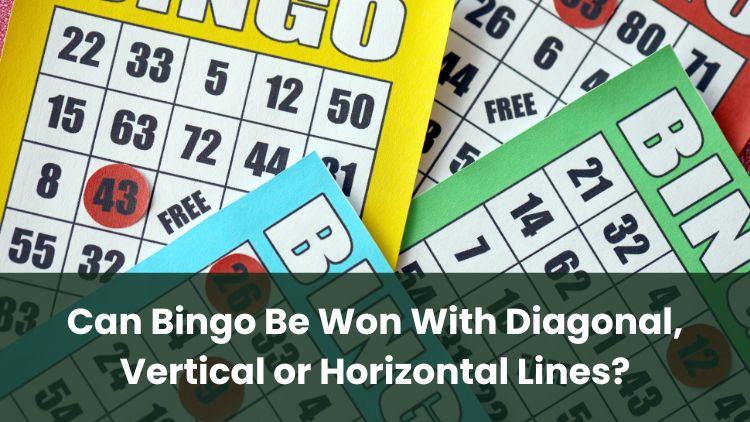
If you are new to bingo, it may seem that the winning routes come in many shapes. Some stretch across, others form columns, and a few even run from corner to corner. Understanding which of these actually count can take a little time.
This blog post explains the main winning lines you are likely to see, how patterns are selected, and whether diagonal, vertical, or horizontal lines can each be recognised. It also covers how wins are confirmed and what familiar terms like full house mean as everything links together.
Read on to see how it all connects.
How Do Bingo Wins Work?
A bingo win occurs once the numbers called match a pattern chosen for that round. What that pattern looks like depends on the type of session being played. Some games award smaller prizes before others, and each stage leads towards the final goal.
In most formats, you will see three general stages during play. The first may appear after a single line is completed, then another prize after two lines, and finally one more once the entire card is filled. Each of these moments has its own title, which we will return to later.
When a pattern is completed, the result must be checked. In a hall, this usually means alerting the caller; online, the system verifies automatically. Payouts are made according to the pattern and how many players achieve it at once. If more than one person finishes the same stage together, the prize is usually shared.
Now that the sequence is clearer, a common question may arise: What about diagonals?
Can You Win Bingo Diagonally?
At first glance, a diagonal line from corner to corner may look as though it should count. In some forms of the game, it does. These sessions often appear as part of themed or pattern-based formats, where different shapes or layouts are used.
However, not every version includes them. Many traditional games focus on the more familiar straight rows and the full completion of the card, unless stated otherwise. Because of this, if you choose to play, it helps to read the details shown before the first number is called so you know what qualifies.
If diagonals are part of the session, they will be mentioned clearly before play begins. The same applies to lines that run top to bottom.
Can You Win Bingo Vertically?
A vertical win means a single column being marked from top to bottom. Some bingo sessions include this within their recognised lines, while others feature only the rows across the card.
Online rounds sometimes highlight verticals as part of limited-time formats, especially where special patterns are featured. When that happens, you will usually see the rule displayed on the screen or ticket. It is worth checking before numbers start being called to confirm which types of line apply for that session.
Next, let’s move to the version most players will recognise.
Can You Win Bingo Horizontally?
Yes. In most traditional formats, this is the line that usually appears first. Completing one row across the card generally earns the opening prize. If the session continues, another prize may follow for two rows on the same ticket, and then another once the whole card has been filled.
Each bingo room or website may set its own sequence, so if you choose to take part, look at the description of that round before it begins. This may help you understand how the prizes are arranged.
What Patterns Count as a Win in Online and Land-Based Bingo?
Every session lists its recognised layouts before play begins. The most common outline looks like this:
- One line: a full row, and sometimes a column or diagonal if allowed
- Two lines: two full rows on the same card
- Full house: every number on the card marked
Beyond these, pattern rounds may ask for corners, letters, or simple shapes. These are often found online or in themed sessions, where the visual element plays a larger part. The pattern to aim for is normally shown clearly on the ticket or digital panel, so players know the goal from the start.
Even a quick glance at this information before play may help ensure the aim of that session is clear.
How Winning Lines Are Confirmed
Once a pattern is complete, it must be verified before it is accepted. In a hall, that involves signalling to the caller, who checks the numbers against those announced. This ensures the result is genuine.
In online formats, the system tracks progress automatically and marks any completed patterns. Prizes are credited once verification is complete, although some promotional rounds may ask for a manual claim, in which case the process is explained in the rules.
Understanding how this checking works provides a clearer picture of how each stage of the game develops and how prizes are awarded.
Understanding Full House and Other Common Bingo Terms
A full house refers to a card where every number has been marked—often the final prize in a standard session. A single line means one complete row, and occasionally a column or diagonal if stated in the rules. Two lines means two full rows on the same card.
The caller is the person announcing numbers in a hall, while a ticket is your numbered card. A jackpot refers to a larger prize, sometimes linked to completing a full house within a certain number of calls. Pattern games require specific shapes or arrangements to be filled for a win.
With these terms now explained, the way bingo wins are recognised becomes clearer. If you choose to play, always do so responsibly, stay within the personal limits you set, and take regular breaks to keep your play balanced and enjoyable.
**The information provided in this blog is intended for educational purposes and should not be construed as betting advice or a guarantee of success. Always gamble responsibly.
